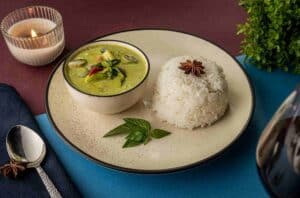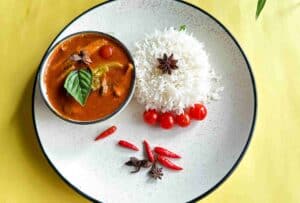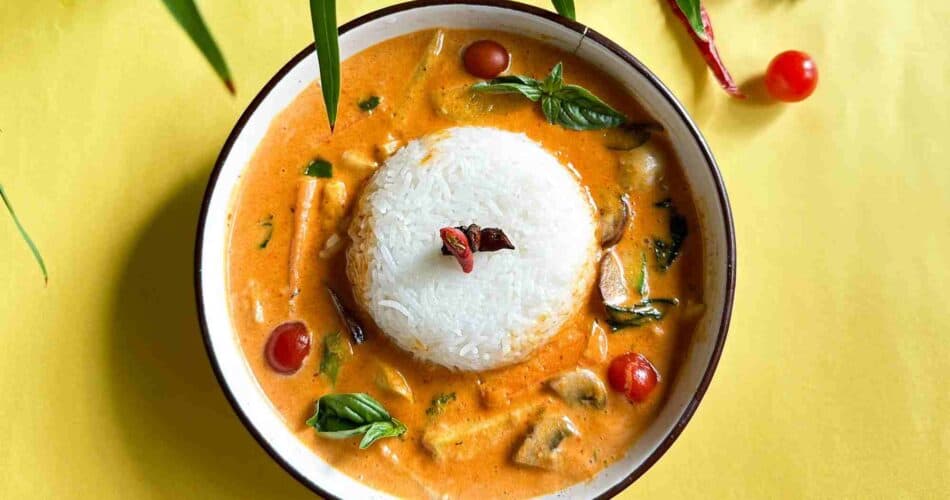A ‘kaeng’ for every taste: Understanding Thai ‘curries’ – and how to Z’Appetite them home
The world outside Thailand calls them ‘curries’, but the Thais have known these palate ticklers as ‘kaeng’ (which, when translated literally, means ‘a watery substance’); for them, a curry (‘kari’) is a dish cooked with Indian curry powder, ‘kaeng’ is not.
Be that as it may, Thai ‘curries’ are the most visible representations of the country’s globally acclaimed cuisine – and not surprisingly, the ones prepared by home chef Abhishek Nawal of We The Chefs, especially his ‘massaman curry’, are a big hit among Z’Appetite customers. Imagine how uncomplicated it is to have your party home-delivered with freshly made ‘traffic signal curries’ – red, yellow and green – with aromatic jasmine rice as the preferred cereal.


Thai curry pastes are either prepared at home (as in the case of Chef Abhishek) or bought freshly made from a local market, or in packaged form off a supermarket shelf. Whatever the source, the ‘kaeng’ paste – the core ingredient of a Thai curry – must contain shrimp paste (which is essential for both flavour and saltiness, although it is avoided by most cooks in India out of respect for their vegetarian clients), chillies (dried or fresh, red or green), onions or shallots, garlic, galangal (close to ginger, but not the same), lemongrass and coriander roots.
To extract the best flavours out of these ingredients, a mortar and pestle is the most effective, but in our busy world, food processors do the job faster, though there is some loss of the essential oils that endow the pastes with their distinctive flavours. To get the best out of the pastes, they are first cooked in fresh coconut milk (in the northern Lanna province, which is famous for its distinctive cuisine, cooking oil is preferred because fresh coconuts are not easily available) and then the other ingredients added.
The choice of ingredients could range from vegetables to jungle fowl, deer meat (venison) and frog’s legs, but globally, cooks settle for mixed vegetables and bamboo shoots, shellfish, chicken, duck or pork. To pump up the flavour quotient, kaffir lime leaves, ‘krachai’ (finger root) and Thai basil, and sometimes even tamarind juice or palm sugar, are added when a ‘curry’ is being cooked. Once the ‘curry’ is ready, the popular lunchtime meal that combines it with jasmine rice is ready to be served along with a helping of shrimp paste and chopped- up bird’s eye chillies. The condiment completes the experience.
What are the different curries called in Thailand? So, you have the ‘kaeng khao wian’, the ‘sweet green curry’; ‘kaeng kari’, the ‘curry curry’, or ‘yellow curry’, and ‘kaeng phet’, the ‘spicy curry’, better known as the ‘red curry’. Now, where does the ‘kaeng matsaman’, or our popular ‘massaman curry’, fit in?
Derived from ‘mosalman’, a popular word used to describe a Muslim, the spicy, creamy ‘kaeng matsaman’ is clearly a fusion dish drawing on the culinary traditions of Persia, India and the Malayan archipelago. It is said to have been introduced by a Persian merchant named Sheikh Ahmad Qomi in the 1600s to the royal court of Ayutthaya in central Thailand.
Rama II, the second king of the Chakri dynasty (and an ancestor of Thailand’s present monarch), who ruled from 1809 till his death in 1824, burst into poetry to express his love for the dish. “Massaman, a curry made by my beloved, is fragrant of cumin and strong spices / Any man who has swallowed the curry is bound to long for her,” gushed the king.
The mention of cumin, incidentally, gives away the uniqueness of the massaman curry, for its paste combines the best of Thailand – dried chilli peppers, coriander seeds, lemongrass, galangal, garlic, white pepper, lemongrass and shrimp paste – with spices from the Middle East and India introduced into Thailand by Muslim traders in the 17th century. These spices include cardamom, cinnamon, cloves, star anise, cumin, bay leaves, nutmeg and mace – and because these were very expensive in the early days, allowing only the royalty to savour them, the earliest fans of the massaman curry were princes and kings such as Rama II.
Apart from its eclectic spice mix, the massaman curry stands apart because of its creaminess, as a result of the generous helpings of both coconut cream and coconut milk that go into it, the use of potatoes and onions along with the central ingredient – beef, mutton, duck or chicken (and tofu for the vegetarians) – and the addition of tamarind paste, palm sugar and peanuts. Nothing is left out in the making of a massaman curry. Little wonder then that it is an umami bomb.
You can order Thai curry platter for your next house party, but give us at least 12 hours’ notice and remember, your minimum order should not be less than Rs 2,999/-

